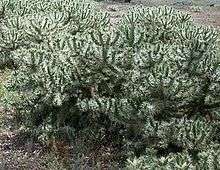Cylindropuntia rosea
| Cylindropuntia rosea | |
|---|---|
 | |
| Scientific classification | |
| Kingdom: | Plantae |
| (unranked): | Angiosperms |
| (unranked): | Eudicots |
| (unranked): | Core eudicots |
| Order: | Caryophyllales |
| Family: | Cactaceae |
| Genus: | Cylindropuntia |
| Species: | C. rosea |
| Binomial name | |
| Cylindropuntia rosea | |
Cylindropuntia rosea, the Hudson pear, is a cactus Australian botanists attribute to being native to the Sonoran Desert in Arizona and Northwestern Mexico. The plant is an invasive species in Australia. Neither this species name, C. rosea, nor C. tunicata are recognized in North America.
Description
Cylindropuntia rosea, the Hudson pear, has pink flowers and white spines. It has long, white, strong spines can grow up to 1.5 metres high and 3m wide.
It is very similar to Cylindropuntia tunicata which also grows in the same region and has yellow and straw coloured flowers.[1]
Invasive plant species in Australia
Hudson pear is an intentionally introduced species to Australia, where it has become an invasive species and noxious weed, It is spreading from the opal fields around Lightning Ridge, New South Wales, occupying some 60,000 ha,[2] and is also found in Western Australia and Queensland. The plant is spread by stem pieces, and possibly by fruits, that have attached to rubber tires, shoes, humans. Animals are particularly at risk from injury caused by the spines.[3]
Investigations are also being made into the possible use of a biological control agent. The Lightning Ridge Miners Association has been supplying backpacks of herbicide to miners for use where they work and live. Spraying has reduced the occurrence of this plant in the Lightning Ridge area, but constant follow up spraying will be needed for further control. The NSW Government has spent $200,000 on management of this weed.[3]
References
| Wikimedia Commons has media related to Cylindropuntia rosea. |
- ↑ Osmond, Rachel, Weed Alert: Have you seen this plant?, NSW DPI
- ↑ New South Wales: In Lightning Ridge, Brewarrina, Broken Hill, Baradine, Coonamble, and Goodooga, New South Wales.
- 1 2 Country Leader 14 April 2008, p.5